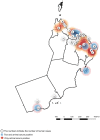Clinical and molecular epidemiology of Crimean-Congo hemorrhagic fever in Oman
- PMID: 31022170
- PMCID: PMC6504112
- DOI: 10.1371/journal.pntd.0007100
Clinical and molecular epidemiology of Crimean-Congo hemorrhagic fever in Oman
Abstract
Background: Crimean-Congo hemorrhagic fever (CCHF) is a serious disease with a high fatality rate reported in many countries. The first case of CCHF in Oman was detected in 1995 and serosurveys have suggested widespread infection of humans and livestock throughout the country.
Methodology: Cases of CCHF reported to the Ministry of Health (MoH) of Oman between 1995 and 2017 were retrospectively reviewed. Diagnosis was confirmed by serology and/or molecular tests in Oman. Stored RNA from recent cases was studied by sequencing the complete open reading frame (ORF) of the viral S segment at Public Health England, enabling phylogenetic comparisons to be made with other S segments of strains obtained from the region.
Findings: Of 88 cases of CCHF, 4 were sporadic in 1995 and 1996, then none were detected until 2011. From 2011-2017, incidence has steadily increased and 19 (23.8%) of 80 cases clustered around Eid Al Adha. The median (range) age was 33 (15-68) years and 79 (90%) were male. The major risk for infection was contact with animals and/or butchering in 73/88 (83%) and only one case was related to tick bites alone. Severe cases were over-represented: 64 (72.7%) had a platelet count < 50 x 109/L and 32 (36.4%) died. There was no intrafamilial spread or healthcare-associated infection. The viral S segments from 11 patients presenting in 2013 and 2014 were all grouped in Asia 1 (IV) lineage.
Conclusions: CCHF is well-established throughout Oman, with a single strain of virus present for at least 20 years. Most patients are men involved in animal husbandry and butchery. The high mortality suggests that there is substantial under-diagnosis of milder cases. Preventive measures have been introduced to reduce risks of transmission to animal handlers and butchers and to maintain safety in healthcare settings.
Conflict of interest statement
The authors have declared that no competing interests exist.
Figures




Similar articles
-
Crimean-congo haemorrhagic fever: a seroepidemiological and tick survey in the Sultanate of Oman.Trop Med Int Health. 2000 Feb;5(2):99-106. doi: 10.1046/j.1365-3156.2000.00524.x. Trop Med Int Health. 2000. PMID: 10747269
-
Crimean Congo hemorrhagic fever serosurvey in humans for identifying high-risk populations and high-risk areas in the endemic state of Gujarat, India.BMC Infect Dis. 2019 Feb 1;19(1):104. doi: 10.1186/s12879-019-3740-x. BMC Infect Dis. 2019. PMID: 30709372 Free PMC article.
-
Crimean-Congo hemorrhagic fever virus in livestock ticks and animal handler seroprevalence at an abattoir in Ghana.BMC Infect Dis. 2016 Jul 8;16:324. doi: 10.1186/s12879-016-1660-6. BMC Infect Dis. 2016. PMID: 27392037 Free PMC article.
-
Recent progress in molecular biology of Crimean-Congo hemorrhagic fever.Comp Immunol Microbiol Infect Dis. 2007 Sep;30(5-6):375-89. doi: 10.1016/j.cimid.2007.07.001. Epub 2007 Aug 10. Comp Immunol Microbiol Infect Dis. 2007. PMID: 17692916 Review.
-
Changes in the epidemiology of Crimean-Congo hemorrhagic fever: Impact of travel and a One Health approach in the European region.Travel Med Infect Dis. 2025 Mar-Apr;64:102806. doi: 10.1016/j.tmaid.2025.102806. Epub 2025 Jan 25. Travel Med Infect Dis. 2025. PMID: 39870124 Review.
Cited by
-
Crimean-Congo hemorrhagic fever in the Arab world: A systematic review.Front Vet Sci. 2022 Sep 13;9:938601. doi: 10.3389/fvets.2022.938601. eCollection 2022. Front Vet Sci. 2022. PMID: 36176697 Free PMC article.
-
A retrospective study of Crimean-Congo hemorrhagic fever in Iraq.Afr Health Sci. 2024 Mar;24(1):59-68. doi: 10.4314/ahs.v24i1.8. Afr Health Sci. 2024. PMID: 38962343 Free PMC article.
-
Clinical and Epidemiological Characteristics of 30 Fatal Cases of Crimean-Congo Hemorrhagic Fever in Kabul, Afghanistan: A Retrospective Observational Study.Infect Drug Resist. 2023 Jun 2;16:3469-3476. doi: 10.2147/IDR.S410955. eCollection 2023. Infect Drug Resist. 2023. PMID: 37287545 Free PMC article.
-
Crimean-Congo hemorrhagic fever, transfer patterns, vectors and history in Iran and neighboring countries.Vet Res Forum. 2024;15(11):575-582. doi: 10.30466/vrf.2024.2022437.4162. Epub 2024 Nov 15. Vet Res Forum. 2024. PMID: 39807398 Free PMC article. Review.
-
Control strategies for emerging infectious diseases: Crimean-Congo hemorrhagic fever management.Health Sci Rep. 2024 Sep 2;7(9):e70053. doi: 10.1002/hsr2.70053. eCollection 2024 Sep. Health Sci Rep. 2024. PMID: 39229478 Free PMC article.
References
-
- Al-Abri SS, Abaidani IA, Fazlalipour M, Mostafavi E, Leblebicioglu H, Pshenichnaya N, et al. Current status of Crimean-Congo haemorrhagic fever in the World Health Organization Eastern Mediterranean Region: issues, challenges, and future directions. Int J Infect Dis. 2017;58:82–89. 10.1016/j.ijid.2017.02.018 - DOI - PMC - PubMed
-
- Gargili A, Estrada-Peña A, Spengler JR, Lukashev A, Nuttall PA, Bente DA. The role of ticks in the maintenance and transmission of Crimean-Congo hemorrhagic fever virus: A review of published field and laboratory studies. Antiviral Res. 2017;144:93–119. 10.1016/j.antiviral.2017.05.010 - DOI - PMC - PubMed
Publication types
MeSH terms
LinkOut - more resources
Full Text Sources

